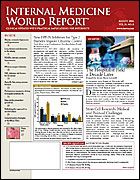Starting With Anti-TNF Therapy, not Steroids, Increases Remission in Crohn's Disease
LOS ANGELES—For patients with recent-onset Crohn’s disease, a “top-down” strategy that starts with the anti–tumor necrosis factor (anti-TNF) agents infliximab (Remicade) and azathioprine (Azasan) was superior in inducing remission than a “step-up” therapy that starts with glucocortico-steroids, reported Daniel Hommes, MD, of the Belgian Inflammatory Bowel Disease Research Group in North Holland, the Netherlands, at Digestive Disease Week.
This open-label, multicenter study included 129 patients with active, newly diagnosed Crohn’s disease or active Crohn’s disease diagnosed <4 years previously who had never been treated with glucocorticosteroids or immunomodulators. Participants were randomized to step-up or top-down therapy.
Top-down therapy consisted of 3 infusions of infliximab (weeks 0, 2, and 6) combined with azathioprine, 2.0 to 2.5 mg/kg daily. Relapses were treated with repeat infliximab infusions and the addition of glucocorticosteroids for patients who did not respond to the initial infliximab regimen.
Step-up therapy started with budesonide capsules (Entocort) 9 mg/day or systemic prednisone (eg, Orasone, Deltasone) 40 mg/day. If unsuccessful, this regimen was followed by azathioprine. Infliximab was administered only after failure of immunosuppression.
The coprimary end points were remission at 6 and 12 months, although endoscopic assessment continued for 24 months. Remission was defined as a Crohn’s Disease Activity Index <150 without requiring glucocorticosteroids or resection.
Top-down therapy resulted in significantly more remissions and a trend toward fewer surgeries at 6 and 12 months. The number of Crohn’s lesions at 24 months was reduced in both groups, but significantly more patients in the top-down group had complete ulcer disappearance (Table).
Total days of steroid use was significantly lower with the top-down approach. One third of patients in the step-up group required infliximab for disease control by 24 months. The rate of adverse events was similar in both groups. There were no lymphomas in either group, and opportunistic infections were rare.
“The top-down strategy was superior in inducing and maintaining steroid-free remission and in mucosal healing,” said Dr Hommes. “It greatly reduces the use of steroids and ultimately could alter the natural history of Crohn’s disease.”
Although top-down therapy has many advantages, its potential for immunogenicity, loss of response, cost, and long-term safety issues may limit its wholesale application, said Bruce E. Sands, MD, comedical director of the Crohn’s and Colitis Center at Massachusetts General Hospital, Boston.
Analysis of a large registry of patients being treated for Crohn’s disease provides reassurance about the safety of infliximab. Concerns about lymphoma have been raised about anti-TNF agents, especially infliximab. In this registry of 6273 patients, the rates of cancer or lymphoma in those treated with infliximab were no greater than the rates in patients treated with other therapies for Crohn’s disease, said Gary Lichtenstein, MD, associate director, Inflammatory Bowel Disease Program, University of Pennsylvania Health System, Philadelphia.
The data represent 8314 patient-years of infliximab treatment in 3272 patients. There were no differences in mortality or in the rates of congestive heart failure between the infliximab recipients and the patients treated with other Crohn’s disease therapies.
P
The hazard ratio for serious infections within 3 months of infliximab use (compared with no infliximab use) was 1.9 ( <.001). Cox proportional hazard analysis showed that infliximab was not an independent predictor of serious infections. In contrast, both prednisone and narcotics were independently associated with serious infection on Cox analysis.
With infliximab, “the benefit is still clearly outweighing the risk at this time,” said Dr Lichtenstein.
